About The Conspiracy Theory of Helene...
SURPRISE! It's NOT Cow Farts!!
There is a rather interesting conspiracy theory floating around that has some folks CONviced Helene was man made and was controlled by mad scientists who work for the world Lithium consortium to level Ashville North Carolina so the lithium could be stolen from the people Wellllll….I’d have to agree with Jon Rappoport for sure on this one!
Any of you have the slightest idea why we have had unseasonably hot weather this year? This should be common knowledge but it isn’t. Why? Because it puts a major damper on the whole concept of global warming or cooling or whatever the control freaks come up with in their demented minds in the misinformation category. I’m going to share with you so that it will become more understood. What do you suppose could happen if an underwater explosion sent
146 million tons of water
from the South Pacific Ocean into the stratosphere? Yes, you read that right ONE HUNDRED FORTY SIX MILLION TONS OF WATER! The amount of water vapor ejected was 10 percent of the stratosphere's typical stock. It was enough to temporarily warm the surface of Earth. It is estimated that an excess of water vapor should remain for 5–10 years.
December 2021
After staying relatively inactive since 2014, the Hunga Tonga–Hunga Haʻapai volcano erupted on 20 December 2021, sending particulates into the stratosphere. A large plume of ash was visible from Nukuʻalofa, the capital city of Tonga, about 70 km (43 mi) from the volcano. The Volcanic Ash Advisory Center (VAAC) in Wellington, New Zealand, issued an advisory notice to airlines. This initial eruption ended at 02:00 on 21 December 2021.
On 22 and 23 December 2021, 8-to-14-kilometre-high (5.0 to 8.7 mi) plumes containing sulfur dioxide drifted to the north-north-east and spread over the Niuatoputapu, Haʻapai and Vavaʻu island groups. Surtseyan explosions, steam plumes and steam bursts were recorded by a Tonga Navy crew on 23 December 2021, during which time the first ground-based images of the eruption were created.
Between 24 and 27 December 2021, steam and gas emissions reached altitudes of 10.3–12.2 kilometres (6.4–7.6 mi). Ash plumes reached heights of only 3 km (1.9 mi), depositing ash only adjacent to the volcano. On 25 December 2021, satellite imagery revealed that the island had increased in size by 300–600 meters (980–1,970 ft) on its eastern side. During 29–30 December 2021, several surges of Surtseyan activity occurred, some of which were witnessed by passengers on a small South Seas Charters boat. Eruption plumes during the second half of December 2021 interrupted air travel to Tonga multiple times.
January 2022
As activity on the island decreased, it was declared dormant by the Tonga Geological Services on 11 January 2022. A large eruption commenced on 14 January 2022 at 04:20 local time (15:20 UTC, 13 January), sending clouds of ash 20 km (12 mi) into the atmosphere. The government of Tonga issued a tsunami warning to residents, and waves of 30 cm (12 in) were observed in Nuku'alofa. Later in the afternoon, Tongan geologists near the volcano observed explosions and a 5-kilometre-wide (3.1 mi) ash column between 17:00 and 18:30 local time. A much larger Plinian eruption started the following day (15 January 2022) at 17:14 local time (04:14:45 UTC, 15 January). The eruption column from this eruption rose 58 km (36 mi) into the mesosphere. The VAAC again issued an advisory notice to airlines. Ash from the eruption made landfall on the main island of Tongatapu, blotting out the sun. Loud explosions were heard 65 km (40 mi) away in Nukuʻalofa, and small stones and ash rained down from the sky. Many residents in Tonga were stuck in traffic whilst attempting to flee to higher ground.
A four-hour observation of the January 2022 eruption over the southern Pacific Ocean from the GOES-West satellite
Shockwave from the Hunga Tonga eruption captured by GOES-17 (GOES-West) and shown using the Mid-level Water Vapor
The explosion was heard in Samoa, roughly 840 km (520 mi) away before the sound travelled to more distant countries. Residents in Fiji, more than 700 km (430 mi) away, described the sounds of thunder, while the "thump" of the eruption was also reported in Niue and Vanuatu. Tremors and shaking buildings were reported by residents in south-western Niue, around Alofi and Avatele. The United States Geological Survey estimated the eruption at a surface-wave magnitude of 5.8. The eruption was heard more than 2,000 km (1,200 mi) away in New Zealand, where the sound arrived two hours later. A series of bangs were heard around 3:30 a.m. local time in and around Anchorage, Alaska, approximately 9,300 km (5,800 mi) away from the volcano, lasting about 30 minutes. Low-frequency noise persisted for approximately two hours. Booms were heard as far away as Yukon in Canada, 9,700 km (6,000 mi) away.
The volcanic explosion caused atmospheric shockwaves to propagate around the globe. Satellites visually captured shockwaves propagating across the Pacific Ocean and a very wide eruption column. The pressure wave was measured by weather stations in many locations, including New Zealand to a maximum amplitude of about 7 hPa, and Australia to 6.9 hPa at Lord Howe Island and 3.3 hPa at Perth. Even in Europe, a pressure fluctuation of 2.5 hPa was measured in Switzerland, and of just over 2 hPa when it reached the United Kingdom. Shockwaves were reported as having gone around the Earth as many as four times in Japan and Utah, and at least twice at the Blue Hill Meteorological Observatory in Massachusetts. The pressure shockwave was also observed in Chennai, India, which is 12,000 km from the eruption site.
Intense lightning activity was recorded during the eruption phase. The Vaisala Global Lightning Dataset GLD360 detected lightning in the form of radio waves. Several hundred to a thousand flashes of lightning were recorded by the system during the two weeks before the eruption. From 14 to 15 January 2022, tens of thousands of lightning flashes occurred. Between 05:00 and 06:00 UTC on 15 January 2022, 200,000 flashes were recorded.
Preliminary observations showed that the eruption column ejected a large amount of volcanic material into the stratosphere, leading to speculation that it would cause a temporary climate cooling effect. Later calculations showed it injected an estimated 400,000 tons of sulfur dioxide into the stratosphere and was unlikely to have any global cooling effect. Despite this, the eruption had a cooling effect in the Southern Hemisphere, causing slight cooling of winters and spectacular sunsets. People living in the Southern Hemisphere experienced purple sunsets for a few months after the eruption. A cooling effect of 0.1–0.5 °C (0.18–0.90 °F) was expected to last until spring (September–November) 2022. The eruption was described as a once-in-a-thousand-year event for the Hunga caldera.
NASA satellite Aura detected the eruption using its microwave limb sounder. It measures ozone, water vapor and other atmospheric gases, and can penetrate obstacles such as ash clouds. The underwater explosion also sent 146 million tons of water from the South Pacific Ocean into the stratosphere.
(Just for your information, that is 4,636,187,006 gallons of water, that’s
ꜰᴏᴜʀ Billion, ꜱɪx ʜᴜɴᴅʀᴇᴅ ᴛʜɪʀᴛʏ ꜱɪx Million, ᴏɴᴇ ʜᴜɴᴅʀᴇᴅ ᴇɪɢʜᴛʏ ꜱᴇᴠᴇɴ Thousand, Six, ɢᴀʟʟᴏɴꜱ ᴏꜰ ᴡᴀᴛᴇʀ.. LET THAT SINK IN! ~ C.L.)
The amount of water vapor ejected was 10 percent of the stratosphere's typical stock. It was enough to temporarily warm the surface of Earth. It is estimated that an excess of water vapor should remain for 5–10 years.
Academic research
(picture above: An image from the International Space Station of the spreading high-altitude smoke cloud)
According to a March 2022 paper in the journal Earthquake Research Advances (ERA), Hunga Tonga–Hunga Haʻapai's plume reached a peak height of 58 kilometres (36 mi) into the atmosphere and sustained heights greater than 30 km (19 mi). The initial explosive event was possibly more powerful than the Hatepe eruption, even though Hatepe ejected over ten times the volume of material in a longer eruption. Hunga Tonga–Hunga Haʻapai erupted over a span of 12 hours, releasing 1.9 km3 (0.46 cu mi) of ejecta with an estimated mass of 2,900 tera grams.
Although the eruption energy was soon estimated from the acoustic waves and the ash cloud, its ranking on the Volcanic Explosivity Index (VEI) is still debated. The ERA paper says the eruption correlated to a VEI of 5–6. An April 2022 research paper led by Poli and Shapiro and published by the American Geophysical Union indicates that the eruption is the largest ever observed with modern instrumentation and estimates its VEI to be approximately 6. Meanwhile, Vergoz and others estimate the blast yield to be 100–200 megatons of TNT and place the corresponding VEI at 5.8. Likewise, a study by Diaz and Rigby estimates the energetic output of the eruption to be equivalent to 61 megatons of TNT, making the event more powerful than the largest nuclear bomb ever detonated (Tsar Bomba). The Smithsonian Institution Global Volcanism Program rated the eruption at VEI-5, while others have rated the eruption at VEI-4.
The ERA paper also concludes that this eruption resulted in the formation of a new caldera. In May 2022, scientists at the National Institute of Water and Atmospheric Research (NIWA) released a bathymetry map indicating a large caldera measuring 4 km (2.5 mi) in width formed from the eruption. Surveys also indicated that the caldera floor is located 850 m (2,790 ft) below sea level. According to a volcanologist, the caldera walls continue to experience ongoing collapses. Surveys of the seafloor around the volcano found large sediment piles, layers of fine mud and ash, and valleys up to 50 km (31 mi) from the volcano. The survey indicated that an estimated 6–7 km3 (1.4–1.7 cu mi) of debris was added to a 22,000-square-kilometre-area (8,500 sq mi) seafloor. Scientists also suggest that the volcano may still be erupting underwater.
A 2022 study in the journal Ocean Engineering by Heidarzadeh and others determined the size of the initial tsunami caused by the eruption. The study analyzed data from 22 tide gauges, eight Deep-ocean Assessment and Reporting of Tsunamis (DART) stations, eight atmospheric pressure time series, spectral analysis and computer simulation. It was concluded that the eruption displaced 6.6 km3 of seawater, 90 m (300 ft) in amplitude, with a length of 12 km (7.5 mi). The displacement generated a number of waves in the atmosphere, including lamb waves in the troposphere and in higher layers of the atmosphere, which propagated around the world at speeds close to the speed of sound.
In mid-May 2024, oceanagrapher Roxanne Beinart published a study in the journal Nature Communications Earth and Environment which concluded that the eruption blanketed the surrounding ocean floor with ash for several months, decimating the local marine wildlife. Beinart had led a research cruise in the South Pacific in April 2022 to research underwater biology living around deep-sea hot springs in the region. She found that the site near the volcano was covered in ash, with some of it even at a depth of 2.4 km (1.5 mi) underwater.
Hunga Tonga-Hunga Haʻapai in December 2021
Hunga Tonga-Hunga Haʻapai in February 2022, after the eruption
Climate and atmospheric impact
The eruption produced a high eruption column, reaching elevations of 57 kilometres (35 mi) and thus reaching into the mesosphere; this is the highest known eruption column in history. The column developed multiple "umbrella"-like clouds, a higher one in the stratosphere and a lower at about 17 km (11 mi) elevation, and generated a terrestrial gamma-ray flash. The column injected a large quantity of water into the stratosphere, where it disturbed the local temperature balance and caused the formation of anomalous winds.
Large volcanic eruptions can inject large amounts of sulfur dioxide into the stratosphere, causing the formation of aerosol layers that reflect sunlight and can cause a cooling of the climate. In contrast, during the Hunga Tonga–Hunga Haʻapai eruption this sulfur was accompanied by large amounts of water vapour, which by acting as a greenhouse gas overrode the aerosol effect and caused a net warming of the climate system. One study estimated a 7% increase in the probability that global warming will exceed 1.5 °C (2.7 °F) in at least one of the next five years, although greenhouse gas emissions and to mitigate them remain the major determinant of this risk. Another study estimated that the water vapor will stay in the stratosphere for up to eight years, and influence winter weather in both hemispheres. More recent studies have indicated that the eruption had a slight cooling effect.
In September 2023, the Antarctic ozone hole was one of the largest on record, at 26 million square kilometers. The anomalously large ozone loss may have been a result of the Hunga Tonga–Hunga Haʻapai eruption.
SURPRISE!!!
So there you have it readers…it isn’t cow farts. It isn’t you BMW exhaust, it isn’t your gas barbeque grille. It’s the Hunga Tonga–Hunga Haʻapai ERUPTION! After all, what goes up, must come down. So expect a few more gallons of those 146 MILLION TONS of water to keep coming down for a short period of time. Well if you consider 100 years a short period.
Volcano eruption in Tonga was a once-in-a-millennium event
The massive explosion of Hunga Tonga-Hunga Ha’apai volcano in Tonga on Saturday (January 15th 2022) was its most powerful eruption since AD 1100. The after-effects have been felt around the globe and the damage is still being assessed.
The volcano, located about 65 kilometres north of Tonga’s capital, Nuku’alofa, exploded with violent force at 5:10pm local time on 15 January. Satellite images show a mushroom cloud of ash billowing 30 kilometres high and later sweeping more than 3000 kilometres west to Australia.
A sea level gauge at Nuku’alofa recorded a tsunami wave of 1.19 metres before it stopped recording, according to Hannah Power at the University of Newcastle in Australia. Videos posted to social media show waves crashing into houses in Tonga, and large waves also reached Japan, prompting evacuation orders, and Peru, where two people drowned at a beach.
The extent of destruction in Tonga is still uncertain because the country’s main undersea phone and internet cable was damaged. New Zealand prime minister Jacinda Ardern said in a press conference on 16 January that she had received reports of boats and large boulders washed ashore in Nuku’alofa and damage to properties, but that there was no news from other coastal areas. No deaths have been reported at this stage.
A New Zealand air force plane was deployed on 17 January to assess the damage, but its findings haven’t yet been reported.



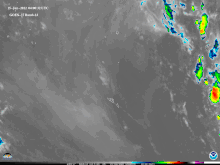
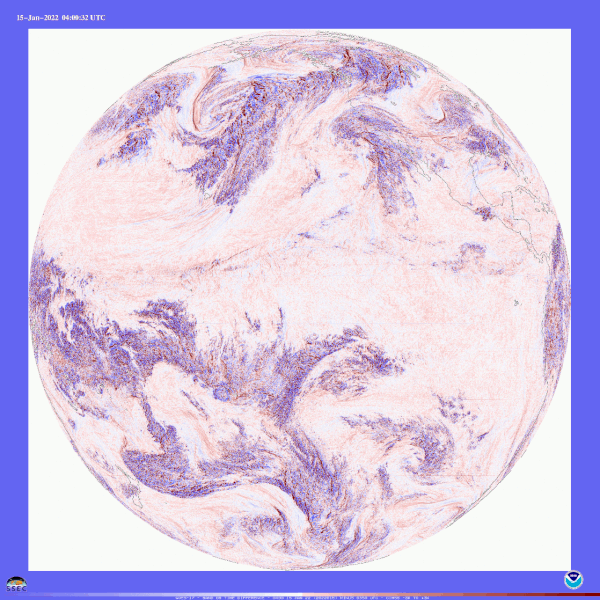
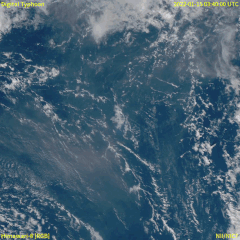


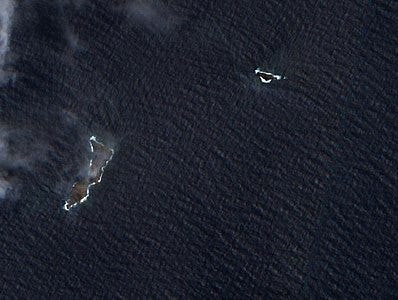
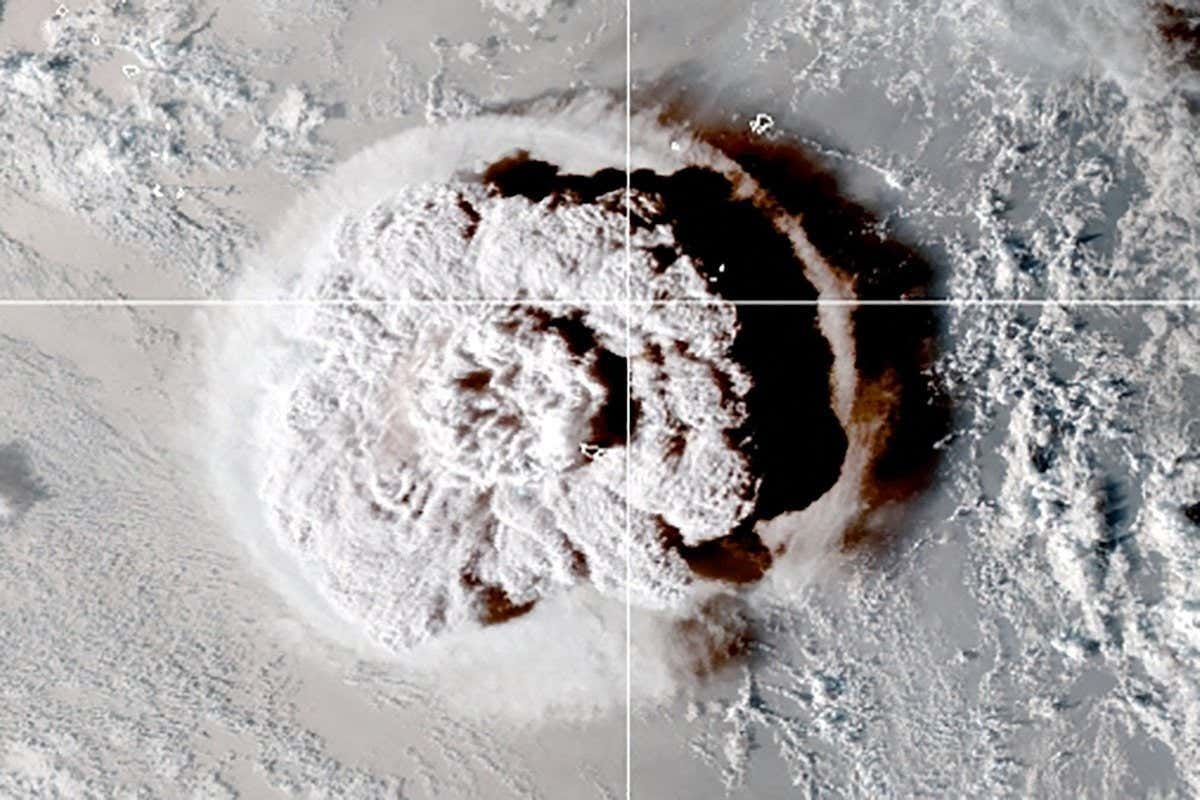

Coffee & Covid writer has talked about this numerous times.
It’s factual. But I still believe we have unprincipled folks messing with our atmosphere & clouds. They think they’re so smart, but like the Gain of Function debacle these types have a God complex. And are playing with fire.
this might explain all the strange hurricanes in the gulf of mexico and the Carribean region